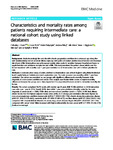Characteristics and mortality rates among patients requiring intermediate care: a national cohort study using linked databases
| dc.contributor.author | Evans, CJ | |
| dc.contributor.author | Potts, L | |
| dc.contributor.author | Dalrymple, U | |
| dc.contributor.author | Pring, A | |
| dc.contributor.author | Verne, J | |
| dc.contributor.author | Higginson, IJ | |
| dc.contributor.author | Gao, W | |
| dc.date.accessioned | 2021-12-10T11:50:33Z | |
| dc.date.issued | 2021-02-12 | |
| dc.identifier.issn | 1741-7015 | |
| dc.identifier.issn | 1741-7015 | |
| dc.identifier.other | 48 | |
| dc.identifier.uri | http://hdl.handle.net/10026.1/18459 | |
| dc.description.abstract |
<jats:title>Abstract</jats:title><jats:sec> <jats:title>Background</jats:title> <jats:p>Adults increasingly live and die with chronic progressive conditions into advanced age. Many live with multimorbidity and an uncertain illness trajectory with points of marked decline, loss of function and increased risk of end of life. Intermediate care units support mainly older adults in transition between hospital and home to regain function and anticipate and plan for end of life. This study examined the patient characteristics and the factors associated with mortality over 1 year post-admission to an intermediate care unit to inform priorities for care.</jats:p> </jats:sec><jats:sec> <jats:title>Methods</jats:title> <jats:p>A national cohort study of adults admitted to intermediate care units in England using linked individual-level Hospital Episode Statistics and death registration data. The main outcome was mortality within 1 year from admission. The cohort was examined as two groups with significant differences in mortality between main diagnosis of a non-cancer condition and cancer. Data analysis used Kaplan-Meier curves to explore mortality differences between the groups and a time-dependant Cox proportional hazards model to determine mortality risk factors.</jats:p> </jats:sec><jats:sec> <jats:title>Results</jats:title> <jats:p>The cohort comprised 76,704 adults with median age 81 years (IQR 70–88) admitted to 220 intermediate care units over 1 year in 2016. Overall, 28.0% died within 1 year post-admission. Mortality varied by the main diagnosis of cancer (total <jats:italic>n</jats:italic> = 3680, 70.8% died) and non-cancer condition (total <jats:italic>n</jats:italic> = 73,024, 25.8% died). Illness-related factors had the highest adjusted hazard ratios [aHRs]. At 0–28 days post-admission, risks were highest for non-cancer respiratory conditions (pneumonia (aHR 6.17 [95%CI 4.90–7.76]), chronic obstructive pulmonary disease (aHR 5.01 [95% CI 3.78–6.62]), dementia (aHR 5.07 [95% CI 3.80–6.77]) and liver disease (aHR 9.75 [95% CI 6.50–14.6]) compared with musculoskeletal disorders. In cancer, lung cancer showed largest risk (aHR 1.20 [95%CI 1.04–1.39]) compared with cancer ‘other’. Risks increased with high multimorbidity for non-cancer (aHR 2.57 [95% CI 2.36–2.79]) and cancer (aHR 2.59 [95% CI 2.13–3.15]) (reference: lowest).</jats:p> </jats:sec><jats:sec> <jats:title>Conclusions</jats:title> <jats:p>One in four patients died within 1 year. Indicators for palliative care assessment are respiratory conditions, dementia, liver disease, cancer and rising multimorbidity. The traditional emphasis on rehabilitation and recovery in intermediate care units has changed with an ageing population and the need for greater integration of palliative care.</jats:p> </jats:sec> | |
| dc.format.extent | 48- | |
| dc.format.medium | Electronic | |
| dc.language | en | |
| dc.language.iso | en | |
| dc.publisher | BioMed Central | |
| dc.subject | Intermediate care facilities | |
| dc.subject | Health services for the aged | |
| dc.subject | Subacute care | |
| dc.subject | Geriatrics | |
| dc.subject | Palliative care | |
| dc.subject | Mortality | |
| dc.subject | Cohort studies | |
| dc.title | Characteristics and mortality rates among patients requiring intermediate care: a national cohort study using linked databases | |
| dc.type | journal-article | |
| dc.type | Article | |
| plymouth.author-url | https://www.ncbi.nlm.nih.gov/pubmed/33579284 | |
| plymouth.issue | 1 | |
| plymouth.volume | 19 | |
| plymouth.publication-status | Published | |
| plymouth.journal | BMC Medicine | |
| dc.identifier.doi | 10.1186/s12916-021-01912-x | |
| plymouth.organisational-group | /Plymouth | |
| plymouth.organisational-group | /Plymouth/Faculty of Health | |
| plymouth.organisational-group | /Plymouth/Faculty of Health/Peninsula Medical School | |
| plymouth.organisational-group | /Plymouth/Faculty of Health/Peninsula Medical School/PMS - Manual | |
| plymouth.organisational-group | /Plymouth/REF 2021 Researchers by UoA | |
| plymouth.organisational-group | /Plymouth/REF 2021 Researchers by UoA/UoA03 Allied Health Professions, Dentistry, Nursing and Pharmacy | |
| plymouth.organisational-group | /Plymouth/Users by role | |
| plymouth.organisational-group | /Plymouth/Users by role/Academics | |
| plymouth.organisational-group | /Plymouth/Users by role/Researchers in ResearchFish submission | |
| dc.publisher.place | England | |
| dcterms.dateAccepted | 2021-01-14 | |
| dc.rights.embargodate | 2021-12-11 | |
| dc.identifier.eissn | 1741-7015 | |
| dc.rights.embargoperiod | Not known | |
| rioxxterms.versionofrecord | 10.1186/s12916-021-01912-x | |
| rioxxterms.licenseref.uri | http://www.rioxx.net/licenses/all-rights-reserved | |
| rioxxterms.licenseref.startdate | 2021-02-12 | |
| rioxxterms.type | Journal Article/Review |


